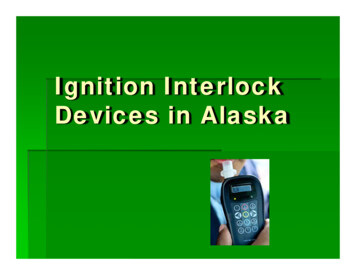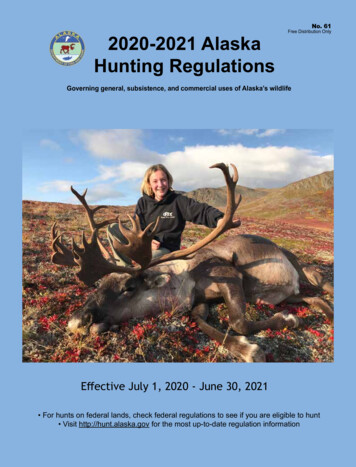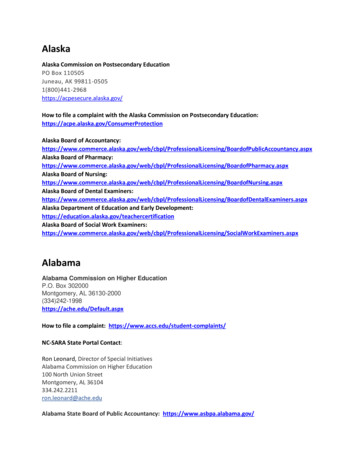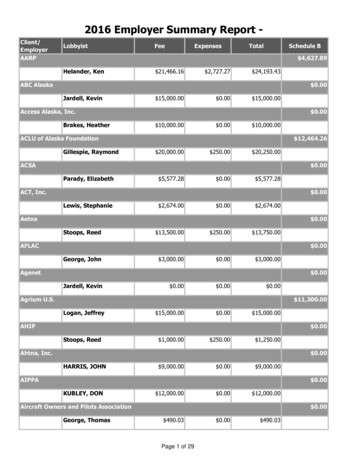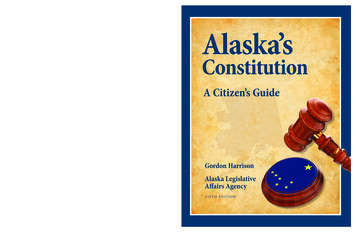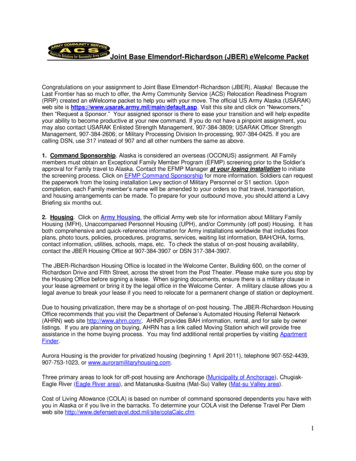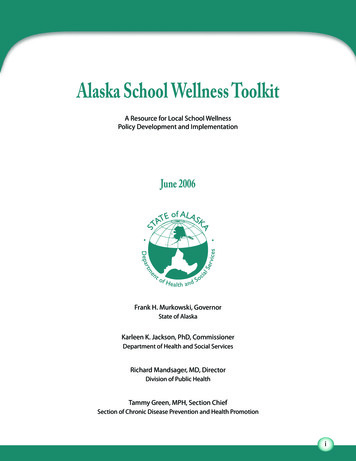
Transcription
ALASKA RULES OF COURTRULES OF EVIDENCETable of ContentsARTICLE I. GENERAL PROVISIONSRule101 Scope and Applicability.(a) General Applicability.(b) Rules of Privilege.(c) Rules Inapplicable.(1) Preliminary Questions of Fact.(2) Miscellaneous Proceedings.102 Purpose and Construction.103 Rulings on Evidence.(a) Effect of Erroneous Ruling.(1) Objection.(2) Offer of Proof.(b) Record of Offer and Ruling.(c) Hearing of Jury.(d) Plain Error.104 Preliminary Questions.(a) Questions of Admissibility Generally.(b) Relevancy Conditioned on Fact.(c) Hearing of Jury.(d) Testimony by Accused.(e ) Weight and Credibility.105 Limited Admissibility.106 Remainder of, or Related Writings or Recorded Statements.ARTICLE II. JUDICIAL NOTICE201202203Judicial Notice of Fact.(a) Scope of Rule.(b) General Rule.(c) When Discretionary.(d) When Mandatory.Judicial Notice of Law.(a) Scope of Rule.(b) Without Request—Mandatory.(c) Without Request—Optional.(d) With Request—Mandatory.Procedure for Taking Judicial Notice.(a) Determining Propriety of Judicial Notice.(b) Time of Taking Notice.(c) Instructing the Jury.ARTICLE III. PRESUMPTIONS301302303Presumptions in General in Civil Actions and Proceedings.(a) Effect.(b) Prima Facie Evidence.(c) Inconsistent Presumption.Applicability of Federal Law in Civil Actions and Proceedings.Presumptions in General in Criminal Cases.1
ALASKA COURT RULES(a) Effect.(1) Presumptions Directed Against an Accused.(2) Presumptions Directed Against the Government.(b) Prima Facie Evidence.(c) Inconsistent Presumptions.ARTICLE IV. ADMISSIBILITY OF RELEVANT 5035045052Definition of Relevant Evidence.Relevant Evidence Admissible—Exceptions—Irrelevant Evidence Inadmissible.Exclusion of Relevant Evidence on Grounds of Prejudice, Confusion, or Waste of Time.Character Evidence Not Admissible to Prove Conduct—Exceptions—Other Crimes.(a) Character Evidence Generally.(1) Character of Accused.(2) Character of Victim.(3) Character of Witness.(b) Other Crimes, Wrongs, or Acts.Methods of Proving Character.(a) Reputation or Opinion.(b) Specific Instances of Conduct.Habit—Routine Practice.Subsequent Remedial Measures.Compromise and Offers to Compromise.Payment of Medical and Similar Expenses.Inadmissibility of Plea Discussions in Other Proceedings.Liability Insurance.Evidence Illegally Obtained.ARTICLE V. PRIVILEGESPrivileges Recognized Only as Provided.Required Reports Privileged by Statute.Lawyer—Client Privilege.(a) Definitions.(b) General Rule of Privilege.(c) Who May Claim the Privilege.(d) Exceptions.(1) Furtherance of Crime or Fraud.(2) Claimants Through Same Deceased Client.(3) Breach of Duty by Lawyer or Client.(4) Document Attested by Lawyer.(5) Joint Clients.Physician and Psychotherapist-Patient Privilege.(a) Definitions.(b) General Rule of Privilege.(c) Who May Claim the Privilege.(d) Exceptions.(1) Condition on Element of Claim or Defense.(2) Crime or Fraud.(3) Breach of Duty Arising Out of Physician-Patient Relationship.(4) Proceedings for Hospitalization.(5) Required Report.(6) Examination by Order of Judge.(7) Criminal Proceeding.Husband-Wife Privileges.(a) Spousal Immunity.(1) General Rule.(2) Exceptions.
RULES OF EVIDENCE(b)506507508509510511512Confidential Marital Communications.(1) General Rule.(2) Exceptions.Communications to Clergymen.(a) Definitions.(b) General Rule of Privilege.(c) Who May Claim the Privilege.Political Vote.Trade Secrets.Identity of Informer.(a) Rule of Privilege.(b) Who May Claim.(c) Exceptions.(1) Voluntary Disclosure—Informer a Witness.(2) Testimony on Merits.(3) Legality of Obtaining Evidence.Waiver of Privilege by Voluntary Disclosure.Privileged Matter Disclosed Under Compulsion or Without Opportunity to Claim Privilege.Comment Upon or Inference From Claim of Privilege—Instruction.(a) Comment or Inference Not Permitted.(b) Claiming Privilege Without Knowledge of Jury.(c) Jury Instruction.(d) Application—Self-Incrimination.ERARTICLE VI. 610611612Competency of Witnesses.Lack of Personal Knowledge.Oath or Affirmation.Interpreters.Competency of Judge as Witness.Competency of Juror as Witness.(a) At the Trial.(b) Inquiry Into Validity of Verdict or Indictment.Who May Impeach or Support.Evidence of Character and Conduct of Witness.(a) Opinion and Reputation Evidence of Character.(b) Specific Instances of Conduct.(c) Admissibility.Impeachment by Evidence of Conviction of Crime.(a) General Rule.(b) Time Limit.(c) Admissibility.(d) Effect of Pardon, Annulment, or Certificate of Rehabilitation.(e) Juvenile Adjudications.(f) Pendency of Appeal.Religious Beliefs or Opinions.Mode and Order of Interrogation and Presentation.(a) Control by Court.(b) Scope of Cross-Examination.(c) Leading Questions.Writing Used to Refresh Memory.(a) While Testifying.(b) Before Testifying.(c) Claims of Privilege or Irrelevance.(d) Failure to Produce.3
ALASKA COURT RULES613614615Prior Inconsistent Statements—Bias and Interest of Witnesses.(a) General Rule.(b) Foundation Requirement.Calling and Examination of Witnesses by Court.(a) Calling by Court.(b) Examination by Court.(c) Objections.Exclusion of Witnesses.ARTICLE VII. OPINION TESTIMONY AND EXPERT WITNESSES7017027037047057068018028034Opinion Testimony by Lay Witnesses.Testimony by Experts.Basis of Opinion Testimony by Experts.Opinion on Ultimate Issue.Disclosure of Facts or Data Underlying Expert Opinion.(a) Disclosure of Facts or Data.(b) Admissibility.(c) Balancing Test—Limiting Instructions.Court Appointed Experts.(a) Appointment.(b) Disclosure of Appointment.(c) Parties’ Experts of Own Selection.ARTICLE VIII. HEARSAYDefinitions.(a) Statement.(b) Declarant.(c) Hearsay.(d) Statements Which Are Not Hearsay.(1) Prior Statement by Witness.(2) Admission by Party-Opponent.(3) Recorded Statement by Child Victims of Crime.Hearsay Rule.Hearsay Exceptions—Availability of Declarant Immaterial.(1) Present Sense Impression.(2) Excited Utterance.(3) Then Existing Mental, Emotional, or Physical Condition.(4) Statements for Purposes of Medical Diagnosis or Treatment.(5) Recorded Recollection.(6) Business Records.(7) Absence of Record.(8) Public Records and Reports.(9) Records of Vital Statistics.(10) Absence of Public Record or Entry.(11) Records of Religious Organizations.(12) Marriage, Baptismal, and Similar Certificates.(13) Family Records.(14) Records of Documents Affecting an Interest in Property.(15) Statements in Documents Affecting an Interest in Property.(16) Statements in Ancient Documents.(17) Market Reports, Commercial Publications.(18) Learned Treatises.(19) Reputation Concerning Personal or Family History.(20) Reputation Concerning Boundaries or General History.(21) Reputation as to Character.(22) Judgment as to Personal, Family, or General History, or Boundaries.
RULES OF EVIDENCE804805806(23) Other Exceptions.Hearsay Exceptions — Declarant Unavailable.(a) Definition of Unavailability.(b) Hearsay Exceptions.(1) Former Testimony.(2) Statement Under Belief of Impending Death.(3) Statement Against Interest.(4) Statement of Personal or Family History.(5) Other Exceptions.Hearsay Within Hearsay.Attacking and Supporting Credibility of Declarant.ERARTICLE IX. DOCUMENTARY EVIDENCE901902903Requirement of Authentication or Identification.Self-Authentication.(1) Domestic Public Documents Under Seal.(2) Domestic Public Documents Not Under Seal.(3) Foreign Public Documents.(4) Certified Copies of Public Records.(5 ) Official Publications.(6) Newspapers and Periodicals.(7) Trade Inscriptions and the Like.(8) Acknowledged Documents.(9) Commercial Paper and Related Documents.(10) Presumptions Created by Law.(11) Certified Records of Regularly Conducted Activity.Subscribing Witness’s Testimony Unnecessary.ARTICLE X. WRITINGS1001 Definitions.(1) Writings and Recordings.(2) Photographs.(3) Original.(4) Duplicate.1002 Requirement of Original.1003 Admissibility of Duplicates.1004 Admissibility of Other Evidence of Contents.(a) Originals Lost or Destroyed.(b) Original Not Obtainable.(c) Original in Possession of Opponent.(d) Collateral Matters.1005 Public Records.1006 Summaries.1007 Testimony or Written Admission of Party.1008 Functions of Court and Jury.ARTICLE XI. TITLE1101 Title5
Rule 101ALASKA COURT RULESARTICLE I. GENERAL PROVISIONSRule 101.Scope and Applicability.(a) General Applicability. These rules apply in allproceedings in the courts of the State of Alaska except asotherwise required by the Constitution of the United States orthis state or as otherwise provided for by enactment of theAlaska Legislature, by the provisions of this rule, or by otherrules promulgated by the Alaska Supreme Court. The word“judge” in these rules includes magistrate judges and masters.(b) Rules of Privilege. The rules with respect toprivileges apply at all stages of all actions, cases, andproceedings.(c) Rules Inapplicable. The rules, other than those withrespect to privileges, do not apply in the following situations:(1) Preliminary Questions of Fact. The determination ofquestions of fact preliminary to admissibility of evidence whenthe issue is to be determined by the judge under Rule 104(a).(2) Miscellaneous Proceedings. Proceedings relating toextradition or rendition; sentencing, probation, or parole;issuance of criminal summonses, or of warrants for arrest orsearch; and summary contempt.(Added by SCO 364 effective August 1, 1979; and amendedby SCO 1829 effective October 15, 2014)Rule 102.Purpose and ConstructionThese rules shall be construed to secure fairness inadministration, elimination of unjustifiable expense and delay,and promotion of growth and development of the law ofevidence to the end that truth may be ascertained andproceedings justly determined.(Added by SCO 364 effective August 1, 1979)Rule 103.Rulings on Evidence(a) Effect of Erroneous Ruling. Error may not bepredicated upon a ruling which admits or excludes evidenceunless a substantial right of the party is affected; and(1) Objection. In case the ruling is one admittingevidence, a timely objection or motion to strike appears ofrecord, stating the specific ground of objection, if the specificground was not apparent from the context; or(2) Offer of Proof. In case the ruling is one excludingevidence, the substance of the evidence was made known tothe court by offer or was apparent from the context withinwhich questions were asked.(b) Record of Offer and Ruling. The court may add anyother or further statement which shows the character of theevidence, the form in which it was offered, the objection made,and the ruling thereon. It may direct the making of an offer inquestion and answer form.6(c) Hearing of Jury. In jury cases, proceedings shall beconducted, to the extent practicable, so as to preventinadmissible evidence from being suggested to the jury by anymeans, such as making statements or offers of proof or askingquestions in the hearing of the jury.(d) Plain Error. Nothing in this rule precludes takingnotice of plain errors affecting substantial rights although theywere not brought to the attention of the court.(Added by SCO 364 effective August 1, 1979)Rule 104.Preliminary Questions.(a) Questions of Admissibility Generally. Preliminaryquestions concerning the qualification of a person to be awitness, the existence of a privilege, or the admissibility ofevidence shall be determined by the court, subject to theprovisions of subdivision (b). In making its determination it isnot bound by the rules of evidence except those with respect toprivileges.(b) Relevancy Conditioned on Fact. When therelevancy of evidence depends upon the fulfillment of acondition of fact, the court shall admit it upon, or subject to,the introduction of evidence sufficient to support a finding ofthe fulfillment of the condition.(c) Hearing of Jury. Hearings on the admissibility ofconfessions shall in all cases be conducted out of the hearingof the jury. Hearings on other preliminary matters shall be soconducted when the interest of justice require or, when anaccused is a witness, if the accused so requests.(d) Testimony by Accused. The accused does not, bytestifying upon a preliminary matter, become subject to crossexamination as to other issues in the case. Testimony given bythe accused at the hearing is not admissible against the accusedunless inconsistent with the accused’s testimony at trial.(e) Weight and Credibility. This rule does not limit theright of a party to introduce before the jury evidence relevantto weight or credibility.(Added by SCO 364 effective August 1, 1979; amended bySCO 1153 effective July 15, 1994)Rule 105.Limited Admissibility.When evidence which is admissible as to one party or forone purpose but not admissible as to another party or foranother purpose is admitted, the court, upon request, shallrestrict the evidence to its proper scope and instruct the juryaccordingly. In cases tried to a jury, evidence inadmissible asto one party shall not be admitted as to other parties until thecourt has made all reasonable efforts to effectively delete allreferences to the parties as to whom it is inadmissible.(Added by SCO 364 effective August 1, 1979)Rule 106.Remainder of, or Related Writings orRecorded Statements.
RULES OF EVIDENCEWhen a writing or recorded statement or part thereof isintroduced by a party, an adverse party may require theintroduction at that time of any other part or any other writingor recorded statement which ought in fairness to be consideredcontemporaneously with it.(Added by SCO 364 effective August 1, 1979; amended bySCO 1153 effective July 15, 1994)ARTICLE II. JUDICIAL NOTICERule 201.Judicial Notice of Fact.(a) Scope of Rule. This rule governs only judicial noticeof facts. Judicial notice of a fact as used in this rule means acourt’s on-the-record declaration of the existence of a factnormally decided by the trier of fact, without requiring proofof that fact.(b) General Rule. A judicially noticed fact must be onenot subject to reasonable dispute in that it is either (1)generally known within this state or (2) capable of accurateand ready determination by resort to sources whose accuracycannot reasonably be questioned.(c) When Discretionary. A court may take judicialnotice as specified in subdivision (b), whether requested or not.(d) When Mandatory. Upon request of a party, thecourt shall take judicial notice of each matter specified insubdivision (b) if the requesting party furnishes sufficientinformation and has given each party notice adequate to enablethe party to meet the request.(Added by SCO 364 effective August 1, 1979)Rule 202.Judicial Notice of Law.(a) Scope of Rule. This rule governs only judicial noticeof law.(b) Without Request—Mandatory. Without request bya party, the court shall take judicial notice of the common law,the Constitution of the United States and of this state, thepublic statutes of the United States and this state, theprovisions of the Alaska Administrative Code, and all rulesadopted by the Alaska Supreme Court.(c) Without Request—Optional. Without request by aparty, the court may take judicial notice of:(1) All duly adopted federal rules of court, and theconstitutions, public statutes and duly adopted regulations andrules of court of every state, territory and jurisdiction of theUnited States.(2) Private acts and resolutions of the Congress of theUnited States and of the legislature of this state and dulypublished regulations of agencies of the United States.(3) Duly enacted ordinances of municipalities or othergovernmental subdivisions, and emergency orders orunpublished regulations adopted by agencies of this state.Rule 301(4) The laws of foreign countries, international law andmaritime law.(5) Any matter of law which would fall within the scopeof this subdivision or subdivision (b) of this rule but for thefact that it has been replaced, superseded or otherwise renderedno longer in force.(d) With Request—Mandatory. Upon request of aparty, the court shall take judicial notice of each matterspecified in subdivision (c) if the requesting party furnishessufficient information and has given each party notice adequateto enable the party to meet the request.(Added by SCO 364 effective August 1, 1979)Rule 203.Procedure for Taking Judicial Notice.(a) Determining Propriety of Judicial Notice. Upontimely request, a party is entitled to be heard as to the proprietyof taking judicial notice and the tenor of the matter noticed. Inthe absence of proper notification, the request may be madeafter judicial notice has been taken. In determining thepropriety of taking judicial notice on a matter or the tenorthereof, the judge may consult and use any source of pertinentinformation, whether or not furnished by a party.(b) Time of Taking Notice. Judicial notice may be takenat any stage of the proceeding.(c) Instructing the Jury. In a civil action or proceeding,the court shall instruct the jury to accept as conclusive any factjudicially noticed. In a criminal case, the court shall instructthe jury that it may, but it is not required to, accept asconclusive any fact judicially noticed. Judicial notice of anymatter of law falling within the scope of Rule 202 shall be amatter for the court and not the jury.(Added by SCO 364 effective August 1, 1979)ARTICLE III. PRESUMPTIONSRule 301.Presumptions in General in Civil Actionsand Proceedings.(a) Effect. In all civil actions and proceedings when nototherwise provided for by statute, by judicial decision or bythese rules, a presumption imposes on the party against whomit is directed the burden of going forward with evidence torebut or meet the presumption, but does not shift to such partythe burden of proof in the sense of the risk of nonpersuasion,which remains throughout the trial upon the party on whom itwas originally cast. The burden of going forward is satisfied bythe introduction of evidence sufficient to permit reasonableminds to conclude that the presumed fact does not exist. If theparty against whom a presumption operates fails to meet theburden of producing evidence, the presumed fact shall bedeemed proved, and the court shall instruct the juryaccordingly. When the burden of producing evidence to meet apresumption is satisfied, the court must instruct the jury that itmay, but is not required to, infer the existence of the presumedfact from the proved fact, but no mention of the word“presumption” may be made to the jury.7
Rule 302ALASKA COURT RULES(b) Prima Facie Evidence. A statute providing that afact or group of facts is prima facie evidence of another factestablishes a presumption within the meaning of this rule.(c) Inconsistent Presumption. If two presumptionsarise which conflict with each other, the court shall apply thepresumption which is founded on the weightier considerationsof policy and logic. If there is no such preponderance, bothpresumptions shall be disregarded.(Added by SCO 364 effective August 1, 1979; and amendedby SCO 1806 effective September 9, 2013)Note: Ch. 80, SLA 2001 enacted a new subsection (b)(8) toAS 34.77.120 concerning the sufficiency of spousal testimonyto rebut presumptions established under AS 34.77.120(b)(5) or(7). According to section 7 of the Act, this new subsection hasthe effect of amending Evidence Rule 301 by changing therule’s general criteria for the evidence that must be introducedto satisfy the burden of proof to rebut the presumptions.Note: Chapter 45, SLA 2013 (HB 65) enacted variouschanges, including amendments to AS 34.77.110 relating tocommunity property, effective September 9, 2013. Accordingto section 47 of the Act, AS 34.77.110(i), enacted by section43 of the Act, has the effect of amending Alaska Rule ofEvidence 301 by specifying the evidence that is sufficient torebut a presumption under AS 34.77.110(i).Rule 302.Applicability of Federal Law in CivilActions and Proceedings.In civil actions and proceedings, the effect of apresumption respecting a fact which is an element of a claim ordefense as to which federal law supplies the rule of decision isdetermined in accordance with federal law.(Added by SCO 364 effective August 1, 1979)Rule 303.Presumptions in General in CriminalCases.(a) Effect.(1) Presumptions Directed Against an Accused. In allcriminal cases when not otherwise provided for by statute, bythese rules or by judicial decision, a presumption directedagainst the accused imposes no burden of going forward withevidence to rebut or meet the presumption and does not shift tothe accused the burden of proof in the sense of the risk of nonpersuasion, which remains throughout the trial upon the partyon whom it was originally cast. However, if the accused failsto offer evidence to rebut or meet the presumption, the courtmust instruct the jury that it may, but is not required to, inferthe existence of the presumed fact from the proved fact, but nomention of the word “presumption” shall be made to the jury.If the accused offers evidence to rebut or meet thepresumption, the court may instruct the jury that it may, but isnot required to, infer the existence of the presumed fact fromthe proved fact, but no mention of the word “presumption”shall be made to the jury.8(2) Presumptions Directed Against the Government. Inall criminal cases when not otherwise provided for by statute,by these rules, or by judicial decision, a presumption directedagainst the government shall be treated in the same manner asa presumption in a civil case under Rule 301.(b) Prima Facie Evidence. A statute providing that afact or group of facts is prima facie evidence of another factestablishes a presumption within the meaning of this rule.(c) Inconsistent Presumptions. If two presumptionsarise which conflict with each other, the court shall apply thepresumption which is founded on the weightier considerationsof policy and logic. If there is no such preponderance, bothpresumptions shall be disregarded.(Added by SCO 364 effective August 1, 1979)ARTICLE IV. ADMISSIBILITY OF RELEVANTEVIDENCERule 401.Definition of Relevant Evidence.Relevant evidence means evidence having any tendencyto make the existence of any fact that is of consequence to thedetermination of the action more probable or less probablethan it would be without the evidence.(Added by SCO 364 effective August 1, 1979)Rule 402.Relevant Evidence Admissible—Exceptions — Irrelevant EvidenceInadmissible.All relevant evidence is admissible, except as otherwiseprovided by the Constitution of the United States or of thisstate, by enactments of the Alaska Legislature, by these rules,or by other rules adopted by the Alaska Supreme Court.Evidence which is not relevant is not admissible.(Added by SCO 364 effective August 1, 1979; amended bySCO 1841 effective October 6, 2014; by SCO 1939 effectiveDecember 26, 2018; and by SCO 1950 nunc pro tunc July 20,2019)Note: Chapter 110 SLA 04 (HB 285) adopts the UniformElectronic Transactions Act. According to Section 3 of theAct, AS 09.80.100, enacted in Section 1, has the effect ofamending Evidence Rule 402 by adding a provision thatprevents electronic evidence of a record or signature frombeing inadmissible as evidence just because it is in electronicform.Note: Chapter 62, SLA 2014 (HB 250), effective October 6,2014, enacted various changes, including a new sectionAS 09.55.544 restricting the evidence that is admissible inmedical malpractice actions.Note: Chapter 108, SLA 2018 (HB 336) enacted a newchapter authorizing Supported Decision-Making Agreementsfor certain purposes. According to section 2 of the Act, AS13.56.150(c), added by section 1 of the Act, has the effect ofchanging Evidence Rule 402 by prohibiting the execution of a
RULES OF EVIDENCEsupported decision-making agreement from being used asevidence of a principal's incapacity (see definitions in AS13.56.190, added by section 1 of the Act).Note: Chapter 12, SLA 2019 (HB 78) enacted a number ofchanges relating to the insurance code. According to section 8of the Act, provisions in sections 3 (enacting AS 21.22.117)and 5 (amending AS 21.22.120) of the Act have the effect ofchanging Evidence Rules 402 and 501, effective July 20, 2019,by creating a new privilege relating to insurance holdingcompanies and insurance holding company systems that wouldprevent a person from being permitted or compelled to testifyabout confidential documents, materials, or information in aprivate civil action. These same provisions preclude theadmissibility of evidence: (a) in a private action, of documents,materials, or other information in the possession or control ofthe National Association of Insurance Commissioners relatingto insurance holding companies and insurance holdingcompany systems; and (b) in a proceeding against certaininsurers or person in an insurance holding company system, ofagreements or documentation relating to insurance holdingcompanies and insurance holding company systems.Rule 403.Exclusion of Relevant Evidence onGrounds of Prejudice, Confusion, orWaste of Time.Although relevant, evidence may be excluded if itsprobative value is outweighed by the danger of unfairprejudice, confusion of the issues, or misleading the jury, or byconsiderations of undue delay, waste of time, or needlesspresentation of cumulative evidence.(Added by SCO 364 effective August 1, 1979; amended bySCO 1716 effective January 1, 2010)Note (effective January 1, 2010): Chapter 44 SLA 2009 (HB102), effective January 1, 2010, enacted changes relating to theUniform Commercial Code. According to section 9 of the Act,AS 45.01.303(g) has the effect of amending Alaska Rules ofEvidence Rule 403 by requiring the exclusion of certainrelevant evidence relating to usage of trade unless certainconditions are met.Rule 404.Character Evidence Not Admissibleto Prove Conduct—Exceptions—Other Crimes.(a) Character Evidence Generally. Evidence of aperson’s character or a trait of character is not admissible forthe purpose of proving that the person acted in conformitytherewith on a particular occasion, except:(1) Character of Accused. Evidence of a relevant trait ofcharacter offered by an accused, or by the prosecution to rebutthe same;(2) Character of Victim. Evidence of a relevant trait ofcharacter of a victim of crime offered by an accused, or by theprosecution to rebut the same, or evidence of a relevantcharacter trait of an accused or of a character trait forRule 404peacefulness of the victim offered by the prosecution in a caseto rebut evidence that the victim was the first aggressor,subject to the following procedure:(i) When a party seeks to admit the evidence for anypurpose, the party must apply for an order of the court at anytime before or during the trial or preliminary hearing.(ii) The court shall conduct a hearing outside thepresence of the jury in order to determine whether theprobative value of the evidence is outweighed by the danger ofunfair prejudice, confusion of the issues, or unwarrantedinvasion of the privacy of the victim. The hearing may beconducted in camera where there is a danger of unwarrantedinvasion of the privacy of the victim.(iii) The court shall order what evidence may beintroduced and the nature of the questions which shall bepermitted.(iv) In prosecutions for the crime of sexual assault in anydegree and attempt to commit sexual assault in any degree,evidence of the victim’s conduct occurring more than one yearbefore the date of the offense charged is presumed to beinadmissible under this rule, in the absence of a persuasiveshowing to the contrary.(3) Character of Witness. Evidence of the character of awitness, as provided in Rules 607, 608, and 609.(b) Other Crimes, Wrongs, or Acts.(1) Evidence of other crimes, wrongs, or acts is notadmissible if the sole purpose for offering the evidence is toprove the character of a person in order to show that the personacted in conformity therewith. It is, however, admissible forother purposes, including, but not limited to, proof of motive,opportunity, intent, preparation, plan, knowledge, identity, orabsence of mistake or accident.(2) In a prosecution for a crime involving a physical orsexual assault or abuse of a minor, evidence of other acts bythe defendant toward the same or another child is admissible ifadmission of the evidence is not precluded by another rule ofevidence and if the prior offenses(i) are similar to the offense charged; and(ii) were committed upon persons similar to theprosecuting witness.(3) In a prosecution for a crime of sexual assault in anydegree, evidence of other sexual assaults or attempted sexualassaults by the defendant against the same or another person isadmissible if the defendant relies on a defense of consent. In aprosecution for a crime of attempt to commit sexual assault inany degree, evidence of other sexual assaults or attemptedsexual assaults by the defendant against the same or anotherperson is admissible.(4) In a prosecution for a crime involving domesticviolence or of interfering with a report of a crime involvingdomestic violence, evidence of other crimes involving9
Rule 405ALASKA COURT RULESdomestic violence by the defendant against the same or anotherperson or of interfering with a report of a crime involvingdomestic violence is admissible. In this paragraph, “domesticviolence” and “crime involving domestic violence” have themeanings given in AS 18.66.990.(Added and amended by SCO 364 effective August 1, 1979;amended by SCO 906 effective nunc pro tunc May 28, 1988;by SCO 1092 effective July 15, 1992; by SCO 1153 effectiveJuly 15, 1994; by SCO 1204 effective July 15, 1995; by SCO1293 effective January 15, 1998; by SCO 1339, effective June13, 1998; and by SCO 1806 effective nunc pro tunc July 1,2013)Note: SCO 906 incorporated changes in Evidence Rule 404made by the legislature in ch. 66, §§ 8 and 9, SLA 1988. Thelegislation added subparagraph (b)(2).Note: SCO 906 is amended by adding a new paragraph 3which provides: “3. This order is made for the sole reason thatthe legislature has mandated the above am
401 Definition of Relevant Evidence. 402 Relevant Evidence Admissible—Exceptions—Irrelevant Evidence Inadmissible. 403 Exclusion of Relevant Evidence on Grounds of Prejudice, Confusion, or Waste of Time. 404 Character Evidence Not Admissible to Prove Conduct—Exceptions—Other Crimes. (a) Character Evidence Generally.
